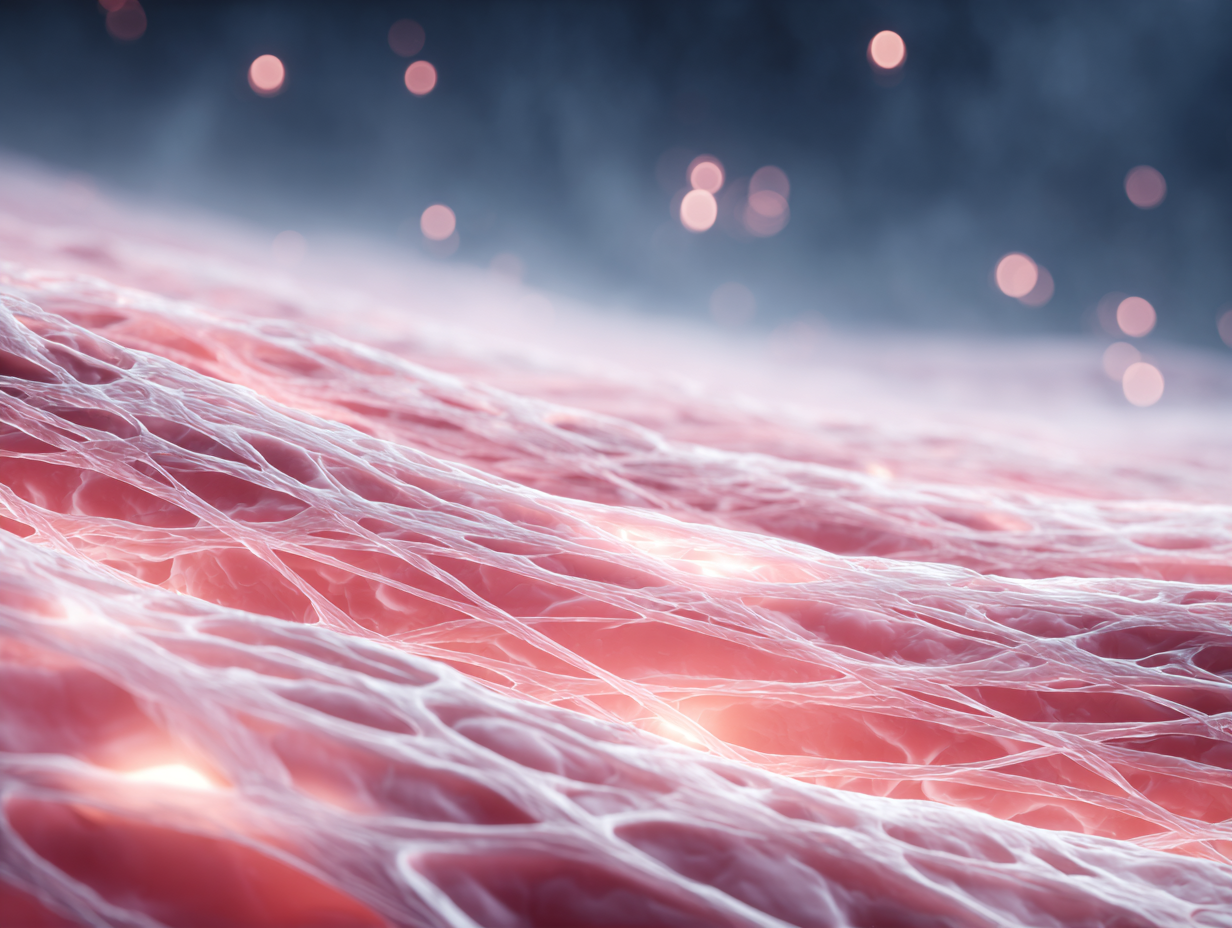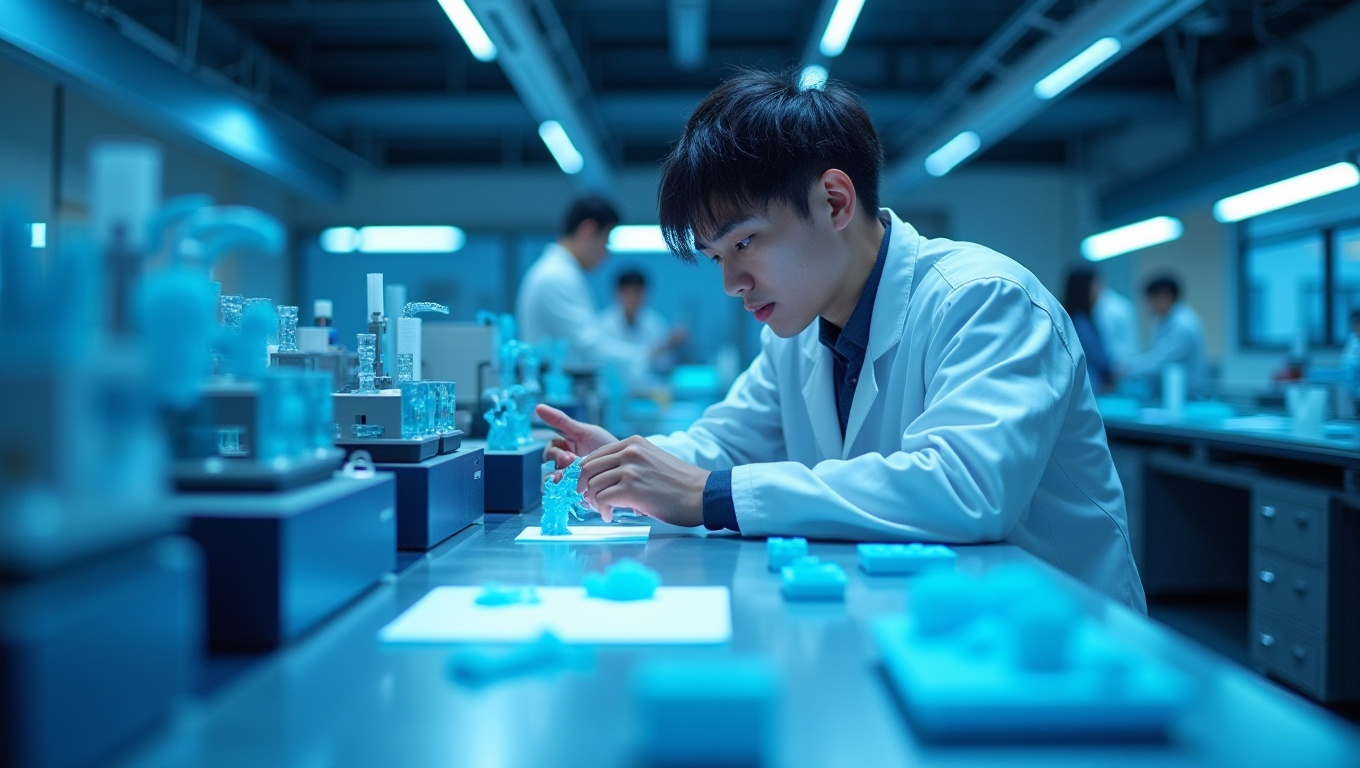
인쇄 기술, 생명을 넘보다
산업용 3D프린팅 기술이 플라스틱과 금속을 넘어 이제는 살아있는 세포를 다루는 영역으로 확장되고 있습니다. ‘바이오프린팅’이라 불리는 이 혁신적인 기술은 특수한 ‘바이오잉크’를 사용하여 피부, 연골, 혈관과 같은 인체 조직, 나아가 이식 가능한 장기를 제작하는 것을 목표로 합니다. 이는 2차원의 디지털 설계를 3차원의 물리적 결과물로 구현한다는 적층 제조의 기본 원리를 공유하지만, 그 대상이 무기물에서 생명체로 바뀌었다는 점에서 제조업의 패러다임을 근본적으로 바꾸는 기술입니다.
바이오프린팅의 성공은 정밀한 하드웨어와 설계 소프트웨어, 그리고 살아있는 세포를 품은 핵심 소재, 바이오잉크의 세 가지 요소에 달려 있습니다. 바이오잉크라는 궁극의 소재를 중심으로, 바이오프린팅의 원리를 통해 산업용 3D프린팅의 무한한 가능성과 장점을 살펴보겠습니다.
생명의 잉크, " 바이오 잉크 "

바이오프린팅의 핵심은 프린터가 아니라 바로 바이오잉크에 있습니다. 이는 단순한 재료가 아니라 살아있는 세포가 조직으로 성장할 수 있도록 설계된 '살아있는 미세 환경' 그 자체입니다. 성공적인 바이오잉크는 상충하는 두 가지 특성을 동시에 만족시켜야 합니다.
- 인쇄적합성(Printability): 프린터 노즐을 통과할 수 있는 적절한 점도와 유동성을 가지면서도, 출력 후에는 구조가 무너지지 않도록 기계적 강도를 유지해야 합니다. 이는 고점도 엔지니어링 플라스틱을 다루는 산업용 3D프린팅과 유사한 물리적 과제입니다.
- 생체적합성(Biocompatibility): 소재 자체에 독성이 없어야 하며, 세포가 안정적으로 부착하고 증식하며 분화할 수 있는 생물학적 환경을 제공해야 합니다.
이 두 가지 조건을 충족시키기 위해, 연구자들은 갈조류에서 추출한 알지네이트, 동물 조직 기반의 콜라겐/젤라틴, 그리고 높은 기계적 강도를 지닌 합성 고분자 PCL/PLA 등 다양한 원료를 활용합니다. 각각의 소재는 연골, 피부, 뼈 등 목표 조직의 특성에 맞춰 선택되며, 이는 특정 기능 구현을 위해 최적의 소재를 선정하는 산업용 3D프린팅의 원리와 정확히 일치합니다.
결국 바이오잉크의 정교한 설계와 선택이 프린팅된 조직의 생존과 기능성을 좌우하며, 이는 소재 기술이 3D프린팅의 성패를 가르는 핵심임을 명확히 보여줍니다.
3D 바이오프린팅 방식과 기술적 과제

바이오프린팅은 목표 조직의 특성과 요구되는 정밀도에 따라 다양한 출력 방식을 사용합니다. 이는 특정 부품의 기능과 대량생산 효율을 고려해 최적의 공법(SLA, FDM, SLS 등)을 선택하는 산업용 3D프린팅과 유사한 접근 방식입니다.
- 압출 기반 방식: 점도가 높은 바이오잉크를 연속적으로 밀어내는 가장 보편적인 방식으로, 기계적으로 튼튼한 구조물 제작에 유리하지만 해상도가 다소 떨어지는 단점이 있습니다.
-
잉크젯 기반 방식: 미세 방울로 잉크를 분사하여 속도가 빠르고 세포 생존율이 높지만, 저점도 잉크만 사용 가능해 구조적 안정성이 약합니다.
- 광 기반 방식(SLA/DLP): 빛을 이용해 바이오잉크를 경화시키는 방식으로, 매우 높은 해상도로 복잡한 구조물을 신속하게 제작할 수 있습니다. 이는 정밀 부품의 대량생산에 널리 쓰이는 SLA 방식과 기술적 뿌리를 공유합니다.
하지만 모든 바이오프린팅 기술은 '정밀도', '구조적 안정성', '생물학적 기능성'이라는 세 가지 목표 사이의 균형점을 찾아야 하는 근본적인 '트릴레마(trilemma)'에 직면합니다. 예를 들어, 정밀도를 높이면 속도가 느려지고, 안정성을 높이면 세포 생존율이 낮아지는 식입니다. 이 과제를 해결하는 것은 결국 재료 과학, 하드웨어 공학, 그리고 공정 제어 기술의 융합에 달려 있으며, 이는 고기능성 부품을 안정적으로 대량생산하려는 3D프린팅서비스기업이 매일 마주하는 도전과 정확히 같습니다.
인공 장기의 마지막 퍼즐: 혈관, 신경, 그리고 면역

완벽한 인공 장기를 만드는 길은 단순히 형태를 출력하는 것에서 그치지 않습니다. 생존과 기능에 필수적인 혈관망과 신경망을 구축하고, 면역 거부 반응을 해결해야 하는 고차원적인 과제가 남아있습니다.
1. 혈관화(Vascularization):
두꺼운 조직 내부에 산소와 영양을 공급하기 위한 혈관망 구축은 바이오프린팅의 가장 큰 난제입니다. 이를 해결하기 위해 쉽게 녹는 임시 소재로 혈관 경로를 만드는 ‘희생 잉크(Sacrificial Ink)’ 기법 등이 개발되고 있습니다. 이는 복잡한 내부 냉각 채널을 가진 금형을 제작하는 산업용 3D프린팅의 고급 기술과 유사한 개념입니다.
2. 면역 거부 반응 극복:
장기 이식의 가장 큰 문제인 면역 거부 반응을 해결하기 위해, 환자 본인의 세포를 역분화시켜 만드는 유도만능줄기세포(iPSC) 기술이 핵심 대안으로 떠오르고 있습니다. 자신의 유전 정보와 완벽히 일치하는 세포를 ‘소재’로 사용함으로써, 거부 반응 없는 완전한 개인 맞춤형 장기 제작이 가능해집니다.
이처럼 바이오프린팅은 혈관, 신경, 면역이라는 마지막 퍼즐을 맞추기 위해 소재 기술의 혁신에 의존하고 있으며, 이는 산업용 3D프린팅이 더 강하고, 더 가볍고, 더 특별한 기능을 가진 소재를 통해 적용 범위를 넓혀가는 모습과 다르지 않습니다.
기술을 넘어 생명을 설계하는 시대를 준비하며

바이오프린팅 기술은 아직 완성되지 않았지만, 장기 부족이라는 인류의 고질적인 문제를 해결하고 개인 맞춤형 재생의학 시대를 열 잠재력을 품고 있습니다. 이 과정에서 우리는 생명을 ‘프린팅’하는 것에 대한 깊은 윤리적, 법적 고민과 마주하게 될 것입니다.
산업용 3D프린팅의 관점에서 바이오프린팅은 제조업의 궁극적인 지향점을 보여줍니다. 그것은 바로 ‘소재’의 한계를 극복하고, 디지털 설계를 통해 원하는 기능을 정확히 구현해내는 것입니다. 플라스틱 부품에서 살아있는 장기에 이르기까지, 그 본질은 다르지 않습니다.
GLUCK은 대량생산이 가능한 산업용 SLA 3D프린팅 서비스 기업입니다. 작은 아이디어를 반복 가능한 생산성으로 전환해, 현실 가능한 제조 솔루션을 제공합니다.
지금 글룩에 문의해 보세요.
📩 제작 및 상담 문의: support@glucklab.com
Bioprinting: The Future of Healthcare with 'Bioink'

Industrial 3D printing is expanding beyond plastics and metals, entering a new frontier—printing with living cells. This emerging field, known as bioprinting, aims to create human tissues such as skin, cartilage, and blood vessels—and eventually transplantable organs—using specialized “bioinks.” While the fundamental principle remains that of additive manufacturing—translating digital blueprints into three-dimensional objects—the materials have shifted from inert substances to living biological matter. This marks a radical shift in the paradigm of manufacturing itself.
At the core of 3D bioprinting are three elements: hardware, design software, and—most critically—bioinks, the material that carries living cells. At GLUCK, we pay particular attention to the role of materials, because in all 3D printing, the final quality and function of the product are defined by the materials used and how they’re handled. In this article, we explore the principles of bioprinting through the lens of bioink, illustrating the limitless possibilities and insights it offers to industrial additive manufacturing.
Bioink: The Ink of Life

In bioprinting, the printer is not the main character—the bioink is. More than just material, bioink is a living microenvironment designed to help cells grow, differentiate, and form tissues.
Successful bioink must satisfy two opposing properties:
- Printability: It needs the right viscosity and flow characteristics to pass through a nozzle while retaining enough mechanical integrity to hold shape after printing—similar to how industrial printers manage high-viscosity engineering plastics.
- Biocompatibility: The material must be non-toxic and provide a biological environment that supports cell adhesion, proliferation, and differentiation.
To meet these conditions, scientists use materials such as alginate from seaweed, collagen/gelatin from animal tissue, and synthetic polymers like PCL or PLA for structural strength. Each bioink is tailored to the specific characteristics of the target tissue—cartilage, skin, bone—mirroring how material selection in industrial 3D printing is dictated by the functional requirements of a product.
Ultimately, the precision and formulation of bioinks determine the viability and functionality of printed tissues, reinforcing the core truth: material science drives 3D printing success.
Bioprinting Techniques and Engineering Challenges

Bioprinting employs different printing techniques based on the type of tissue and required resolution—just as industrial 3D printing selects SLA, FDM, or SLS methods based on functional and production needs.
- Extrusion-based printing: The most common method, which extrudes viscous bioinks to form sturdy structures. It’s ideal for mechanical stability, though resolution may be limited.
- Inkjet-based printing: Uses micro-droplets to deliver cells at high speed with excellent cell viability, but only works with low-viscosity inks and lacks structural strength.
- Light-based printing (SLA/DLP): Utilizes light to cure bioinks layer by layer, offering high resolution and rapid production—sharing the same technical roots as SLA in precision manufacturing.
All bioprinting technologies face a “trilemma”: balancing precision, structural stability, and biological functionality. Improving one often compromises another. Higher resolution can slow production; stronger structures may reduce cell survival. Overcoming this challenge requires integrating material science, hardware engineering, and process control—a familiar balancing act for industrial 3D printing service providers aiming for functional, scalable production.
The Final Puzzle for Artificial Organs: Vessels, Nerves, and Immunity

Creating a perfect organ isn’t just about replicating its shape. Complex systems like blood vessels, nerves, and immune responses must also be engineered.
1. Vascularization
One of the biggest obstacles is forming internal blood vessels that deliver oxygen and nutrients throughout thick tissue. Researchers are developing sacrificial ink techniques that print temporary channels to create vascular pathways—similar to the internal cooling structures found in advanced industrial molds.
2. Overcoming Immune Rejection
Immune rejection is a major challenge in organ transplantation. A promising solution lies in induced pluripotent stem cells (iPSCs)—cells derived from the patient’s own tissue. By printing organs using the patient’s own genetic material, rejection is avoided, enabling fully personalized transplantable organs.
These challenges rely heavily on advancements in material science, echoing how industrial 3D printing extends its reach by developing stronger, lighter, and more functional materials.
Designing Life: Manufacturing Beyond Technology

While bioprinting is not yet mature, it holds tremendous potential to address global organ shortages and usher in a new era of personalized regenerative medicine. But along the way, we must also grapple with the deep ethical and legal implications of “printing life.”
From an industrial 3D printing perspective, bioprinting embodies the ultimate vision: overcoming material limitations to precisely produce functional results from digital blueprints. Whether the outcome is a plastic component or a living organ, the essence is the same.
GLUCK is an industrial SLA 3D printing service company specialized in scalable mass production.
We transform small ideas into repeatable productivity, delivering practical and reliable manufacturing solutions.
📩 Contact GLUCK today for production and consultation: support@glucklab.com
#바이오프린팅 #의료산업 #바이오잉크 #GLUCK #글룩 #3D프린팅 #산업용3D프린팅 #SLA3D프린팅 #대량생산 #DfAM #3D설계 #3D프린팅산업 #3D프린터 #3D모델링 #3D프린팅가격 #3D프린팅업체 #몰드제작 #3D프린팅견적 #3D출력 #Bioprinting #MedicalIndustry #Bioink #MassProduction #3DPrinting #LargescaleProduction #AdditiveManufacturing #SLAtechnology #ManufacturingInnovation #DigitalTransformation #SmartManufacturing
'인사이트 (Insights)' 카테고리의 다른 글
| 국방 기술 혁신의 열쇠 :: 산업용 3D프린팅과 소재 개발의 혁신 (4) | 2025.08.11 |
|---|---|
| 그래스호퍼와 3D프린팅, 알고리즘이 빚어내는 제조 산업 (3) | 2025.08.04 |
| 3D 모델링에서 생산까지, 산업용 3D프린팅의 연결고리 (5) | 2025.07.24 |
| 누구나 메이커가 되는 세상, 산업용 3D프린팅이 바꾼 굿즈 산업 (4) | 2025.07.21 |
| 데이터로 본 한국 3D프린팅 산업과 전략 (0) | 2025.07.21 |
